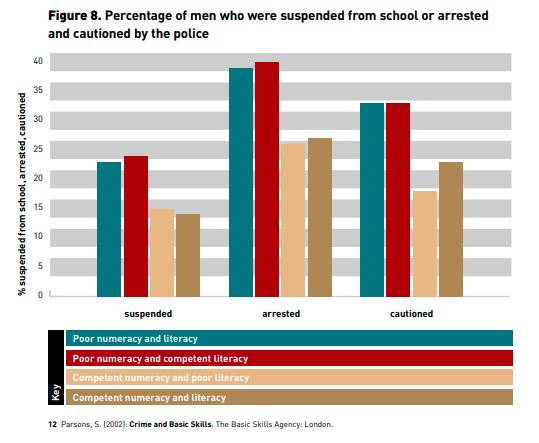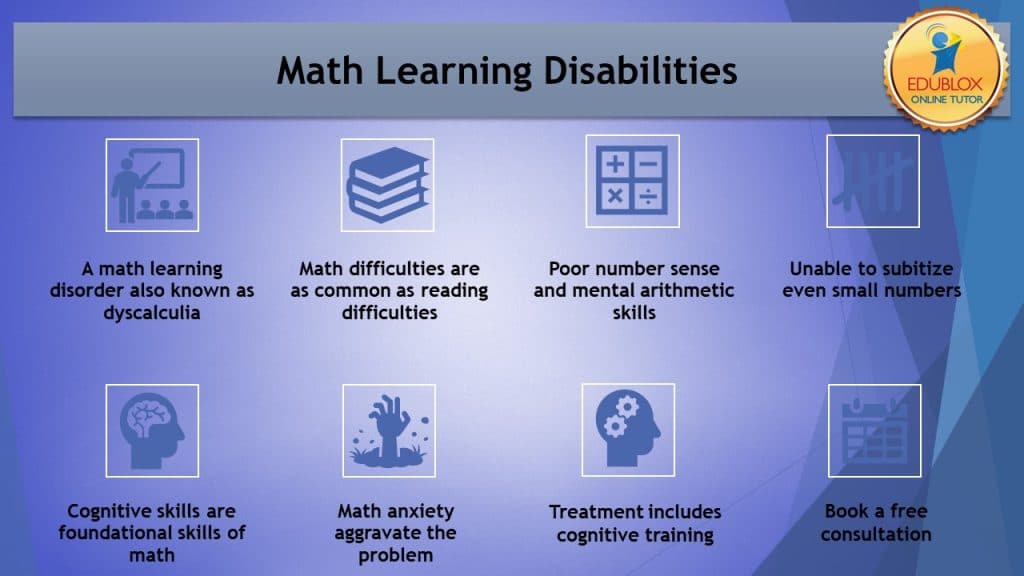
Math is an unavoidable and required knowledge. Whether in science, business, or daily living, we cannot escape the use of numbers. Every job, from the rocket scientist to the sheepherder, requires math! Math is needed no matter the country you live in or the language you speak. The effects of math failure can seriously handicap both daily living and vocational prospects. It may shut the door on a student’s occupational dreams and undermine their aspirations to be president, a doctor, or an engineer.
Table of contents:
- What is a math learning disability?
- Why does numeracy matter?
- How common are math learning disabilities?
- What are the symptoms of math learning disabilities?
- What causes math learning disabilities?
- How can math learning disabilities be treated?
What is a math learning disability?
The definition of a math learning disability includes well below average mathematical academic performance for a person’s age that is not attributable to an intellectual disability (which is defined by IQ below 70). The DSM-5 uses the term ‘Specific Learning Disorder with impairment in mathematics.’
The term dyscalculia, which means inability to calculate, is commonly used to describe math learning disabilities. Other terms include developmental dyscalculia, mathematical learning difficulty, arithmetic learning disability, number fact disorder, math dyslexia, and number dyslexia.
Why does numeracy matter?
Mathematics is integral to our lives, from basic trading at a market stall in Marrakesh or Beijing to the complex algorithms that guide international banking. Math is utilized to work out the time of a journey to see a friend in a nearby town, to the time it takes a sub-atomic particle to travel around CERN’s Large Hadron Collider. We use math when planning a holiday, deciding on a mortgage, or decorating a room. Good numeracy is essential to us as parents helping our children learn, as patients understanding health information, and as citizens making sense of statistics and economic news.
The effects of math failure during the years of schooling, as well as math illiteracy in adult life, can seriously handicap both daily living and vocational prospects.
Low numeracy is a substantial financial cost to governments and a personal cost to individuals. A large UK cohort study found that low numeracy was more of a handicap for an individual’s life chances than low literacy: They earn less, spend less, are more likely to be sick, are more likely to be in trouble with the law, and need more help in school (Parsons & Bynner, 2005).

Research by economists, led by Pro Bono Economics, reveals the damaging impact of poor numeracy on the UK economy. Their report estimates the cost of outcomes associated with low levels of adult numeracy at around £20.2 billion per year, or about 1.3 percent of the UK’s GDP.
In the US, individuals with the lowest literacy and numeracy levels have a higher unemployment rate and earn lower wages than the national average. Low literacy costs the US at least $225 billion each year in non-productivity in the workforce, crime, and loss of tax revenue due to unemployment.
Math learning disabilities can lead to social isolation due to an inability to be at the right place at the right time or to understand the rules and scoring systems of games and sports. In addition, some adults with dyscalculia never learn to drive because of the numerical demands of driving (Hornigold, 2015).
Despite the importance of numeracy, math learning disabilities have received little attention, and the general public’s familiarity with it as a problem is relatively low. For example, between 2000 and 2010, the NIH spent $107.2 million funding dyslexia research but only $2.3 million on dyscalculia (Butterworth et al., 2011).
How common are math learning disabilities?
Among students classified as learning disabled, math difficulties are as prevalent as reading difficulties. According to McLeod and Crump, about one-half of students with learning disabilities require supplemental work in mathematics.
What are the symptoms of math learning disabilities?
Symptoms include:

- The most generally agreed-upon feature of children with dyscalculia is difficulty learning and remembering arithmetic facts.
- The second feature of children with dyscalculia is difficulty executing calculation procedures, with immature problem-solving strategies, long solution times, and high error rates.
- Poor number sense is a core deficit. Number sense refers to a person’s ability to use and understand numbers. For example, they cannot see that 29 + 30 + 31 is the same as 3 x 30.
- An inability to subitize (perceive without counting) even very small quantities. Most people can subitize up to six or seven objects. Children with math learning disabilities may find this very hard and may need to count even small numbers of objects. If, for example, they are presented with two objects, they may count them rather than just knowing there are two.
- Poor understanding of the signs +, -, ÷, and x; may confuse these mathematical symbols.
- Difficulty with addition, subtraction, multiplication, and division or may find it challenging to understand the words “plus,” “add,” and “add-together.”
- Poor mental arithmetic skills.
- An inability to estimate whether a numerical answer is reasonable.
- Immature strategies such as counting all instead of counting on. The child may work out 137 + 78 by drawing 137 dots and then 78 dots and then counting them all.
- They may have trouble even with a calculator due to difficulties in the process of feeding in variables.
- Inability to notice patterns. The world of math is full of patterns, and the ability to see, predict and continue patterns is a key math skill. For example, take the sequence of the 5 x table: 5, 10, 15, 20, 25, et cetera. This is a clear pattern, but a student with math learning disabilities may not spot it readily.
- An inability to generalize. The ability to generalize makes life so much simpler in math, but a student with math learning disabilities may find this very hard. For example, they might not see that knowing that 3 + 4 = 7 means they also know that 30 + 40 = 70, or even that 3 inches + 4 inches = 7 inches.
- Children with math learning disabilities may experience directional confusion, i.e., have difficulty discriminating left from right, and north, south, east, and west. They may have a poor memory for remembering learned navigational concepts: starboard and port, longitude and latitude, horizontal and vertical, and so on.
- They may reverse or transpose numbers, for example, 63 for 36 or 785 for 875.
- Children with math learning disabilities may encounter problems with numbers associated with the measurement of time, for example, one day is equal to 24 hours.
- They may struggle to read a digital and analog clock.
- They may have difficulty with time management, be unable to recall schedules and sequences of past or future events, be unable to keep track of time, and be chronically late. They may be unable to memorize sequences of historical facts and dates; historical timelines may be vague.
- They may have difficulty with everyday tasks like checking change.
- They may have difficulty keeping scores during games.
- They may be unable to grasp and remember mathematical concepts, rules, formulae, and sequences.
What causes math learning disabilities?
Three key factors may influence dyscalculic students’ acquisition of numeracy and later mathematics. These are (1.) cognitive skills, (2.) mathematical language and skills, and (3.) the affective domain, especially anxiety.
Cognitive skills
Research has shown that math’s most important foundational skills are perception, memory, and logical reasoning (which makes problem-solving possible).
Mercer and Pullen (2008) identified three basic problem areas in the perceptual field that affect performance in mathematics: figure-ground differentiation, discrimination, and spatial orientation.
- Figure-ground problems may cause difficulties in keeping individual problems separate from each other. As a result, the student may lose their place on a worksheet, confuse problem numbers with digits in the problem itself, or not finish the problem.
- Visual discrimination problems tend to cause inversions in number recognition, confusion among coins, confusion among operation symbols, confusion between the hands of the clock, and the like.
- Auditory discrimination problems cause confusion in oral counting and among endings of number words, such as /fourteen/, /forty/, et cetera.
- Spatial problems may cause reversals and affect the ability to write problems horizontally or vertically, to understand before-after concepts, to understand the importance of directionality which, in turn, could affect regrouping, and to align rows of numbers with varying digits. Additionally, the child may have problems putting decimals in the right place, using the number line, understanding positive and negative integers, et cetera. Also affected are the ability to tell time, to understand geometry, and any other mathematical concepts related to spatial and temporal orientations and relationships.
Students with math learning disabilities may encounter difficulties with short-term memory, long-term memory, working memory, and visual memory. They may find it challenging to begin a given task because they cannot remember the instructions or need help recalling what they must do to see it through.
Several studies have shown that children with mathematical difficulties underperform on tests of various aspects of working memory, while visual memory may also be problematic for dyscalculic learners. Long-term memory related to mathematical information also plays a key role in learning and remembering important mathematical facts such as simple addition (e.g., 5 + 4) and multiplication facts (e.g., 5 x 4).
Szűcs and team (2013) set out to compare various potential theories of dyscalculia in more than a thousand 9-year-old children. The researchers found that children with dyscalculia showed poor visuospatial memory performance. For example, they performed poorly when they had to remember the locations of items in a spatial grid.
Since problem-solving involves numerous cognitive and linguistic processes, the ability to reason logically is at the heart of mathematics.
Mathematical language and skills
Mathematics has its own language. Mathematics comprises unique words and symbols. From a very young age, children are presented with mathematical terms such as “before,” “after,” “equals,” “more,” and “less.” Moreover, they encounter symbols of which they must learn the meaning, such as +, -, and x. Another key difficulty of math language is found when students with math learning disabilities are asked to tackle word problems.
There are also many things in mathematics that the student must learn to do, such as counting, adding and subtracting, multiplication and division, applying place value and fractions, and reading time.
Math anxiety
Math anxiety is an adverse reaction to math associated with negative emotions. Ashcraft and Faust (1994) define math anxiety as a feeling of tension, helplessness, mental disorganization, and dread produced when one is required to manipulate numbers or solve mathematical problems.
Mathematical tasks can cause high anxiety levels, particularly in mathematics, rather than any other given challenging activity. Ashcraft and Faust found that high math anxious subjects were quite willing to sacrifice accuracy in order to maintain or improve speed. In addition, children with dyscalculia may experience intense fear, which may cause an inability to learn math concepts and skills or perform well on math tests.
Can math learning disabilities be treated?
It should also be noted that learning is a stratified process. Certain skills have to be mastered first, before it becomes possible to master subsequent skills.
To be a basketball player, a person must first master the foundational skills, e.g., passing, dribbling, defense, and shooting. In the same way, to do math, a child must first learn foundational math skills like visual perception and visual memory.
The second step would be to ensure that a student catches up on mathematical language and skills, which must be done sequentially. One has to learn to count before it becomes possible to learn to add and subtract. Suppose one tried to teach a child, who had not yet learned to count, to add and subtract. This would be quite impossible, and no amount of effort would ever succeed in teaching the child these skills. The child must learn to count first, before it becomes possible for him to learn to add and subtract.
Edublox offers help to students with mild to severe math learning disabilities. Our math help consists of the following:
- Developing foundational math skills such as visual and auditory processing; visual, sequential, and working memory; and reasoning.
- Teaching math skills sequentially: counting and skip counting, adding and subtracting, multiplication and division, place value, fractions, decimals, understanding money, reading time, et cetera.
- Teaching an in-depth understanding of math terminology.
Watch our playlist below and book a free consultation to discuss your child’s math learning needs.
Key takeaways

.
Bibliography and references:
Ashcraft, M. H., & Faust, M. W. (1994). Mathematics anxiety and mental arithmetic performance: An exploratory investigation. Cognition and Emotion, 8(2), 97–125.
Butterworth, B., Varma, S., & Laurillard, D. (2011). Dyscalculia: From brain to education. Science.
Butterworth, B., & Yeo, D. (2004). Dyscalculia guidance: helping pupils with specific learning difficulties in maths. London: Fulton Publishers.
Chinn, S. J. (2004). The trouble with maths: a practical guide to helping learners with numeracy difficulties. London: Routledge Falmer.
Cockcroft, W. (1982). Mathematics counts. London: HMSO.
Faust, M. W., Ashcraft, M. H., & Fleck, D. E. (1996). Mathematics anxiety effects in simple and complex addition. Mathematical Cognition, 2(1): 25-62.
Hornigold, J. (2015). Dyscalculia pocketbook. Alresford, Hampshire: Teachers’ Pocketbooks.
McLeod, T. M., & Crump. W. D. (1978). The relationship of visuospatial skills and verbal ability to learning disabilities in mathematics. Journal of Learning Disabililies.
Mercer, C., & Pullen, P. (2008). Students with learning disabilities (7th ed.). Pearson.
Price, G., & Ansari, D. (2013). Dyscalculia: Characteristics, causes, and treatments. Numeracy, 6(1).
Rosselli, M., Matute, E., Pinto, N., & Ardila, A. (2006). Memory abilities in children with subtypes of dyscalculia. Developmental Neuropsychology, 30(3): 801-8.
Rubinsten, O., & Tannock, R. (2010). Mathematics anxiety in children with developmental dyscalculia. Behavioral and Brain Functions, 6: 46.
Szűcs, D., Devine, A., Soltesz, F., Nobes, A., & Gabriel, F. (2013). Developmental dyscalculia is related to visuo-spatial memory and inhibition impairment. Cortex, 49(10), 2674-88.
